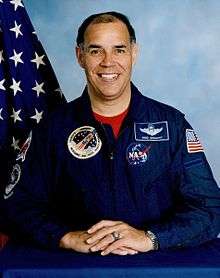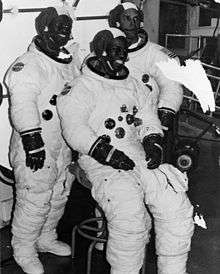Frederick D. Gregory
| Frederick D. Gregory | |
|---|---|
 | |
| Acting Administrator of the National Aeronautics and Space Administration | |
|
In office February 11, 2005 – April 14, 2005 | |
| President | George W. Bush |
| Preceded by | Sean O'Keefe |
| Succeeded by | Michael D. Griffin |
| Personal details | |
| Born |
Frederick Drew Gregory January 7, 1941 Washington, D.C., U.S. |
| Nationality | American |
| Alma mater |
USAFA, B.S. 1964 GWU, M.S. 1977 |
| NASA Astronaut | |
| Status | Retired |
Other occupation | Test pilot |
| Rank | Colonel, USAF |
Time in space | 18d 23h 04m |
| Selection | 1978 NASA Group 8 |
| Missions | STS-51-B, STS-33, STS-44 |
Mission insignia |
|
Frederick Drew Gregory (born January 7, 1941), (Col, USAF, Ret.), is a former United States Air Force pilot, military engineer, test pilot, and NASA astronaut as well as former NASA Deputy Administrator. He also served briefly as NASA Acting Administrator in early 2005, covering the period between the departure of Sean O'Keefe and the swearing in of Michael Griffin.
Personal data
Gregory was born on January 7, 1941, in Washington, D.C.. His father was Francis A. Gregory, an educator who was assistant superintendent for DC Public Schools as well as the first black president of the DC Public Library Board of Trustees. His father has a public library named after him in the Ward 7 Hillcrest neighborhood of Washington, DC. His mother was Nora Drew Gregory, a lifelong educator as well as public library advocate. She was also the sister of noted African-American physician, surgeon and researcher Dr. Charles Drew, who developed improved techniques for blood storage, and applied his expert knowledge in developing large-scale blood banks early in World War II, saving thousands of Allied lives. Gregory's great-grandfather was educator James Monroe Gregory.[1]
Frederick Drew Gregory, Colonel, USAF (Ret.) is a former test pilot, NASA astronaut, and NASA Deputy Administrator. He was born and raised in Washington D.C. graduating from Anacostia High School. He attended the United States Air Force Academy (nominated by New York Congressman, the Reverend Adam Clayton Powell) where he received his undergraduate degree in Military Engineering. He earned his wings after helicopter school, flew in Vietnam, transitioned to fighter aircraft, attended the Navy Test Pilot School, and then conducted testing as an engineering test pilot for both the Air Force and NASA. He received a master's degree from the George Washington University in Information Systems.
During his time in the Air Force, Gregory logged approximately 7,000 hours in more than 50 types of aircraft as a helicopter, fighter and test pilot. He flew 550 combat rescue missions in Vietnam.
In 1978, Gregory applied for and was chosen as a member of the first class of Space Shuttle astronauts.
Gregory became the first American with an African lineage to pilot a space craft, the orbiter Challenger on mission STS-51B. This flight was the second flight for the laboratory developed by the European Space Agency for scientific experiments on the space shuttle. The crew also deployed the Northern Utah Satellite before landing at Edwards Air Force Base. He was then the first person ever of African lineage to command any space mission with the launch of STS-33 in 1989 on the orbiter Discovery, which carried a classified payload. He then commanded STS-44 on Atlantis which in addition to deploying a Department of Defense satellite, DPS 15, also conducted extensive studies to evaluate medical countermeasures to long duration space flight.
After he left the Astronaut Office, he assumed the roles of Associate Administrator for Safety and Mission Assurance and as the Associate Administrator for Space Flight before becoming the NASA Deputy Administrator. As the leader of the agency’s human space flight program and as the Deputy Administrator, one of his biggest goals was to have humans leave low Earth orbit on a journey in which Mars was the first step.
Married to the former Barbara Archer of Washington, D.C. until her death in 2008. They had two grown children. Frederick, D., Jr., a Civil Servant working in the office of the Joint Chiefs of Staff (DOD), and a graduate of Stanford University and the University of Florida. Heather Lynn is a social worker and graduate of Sweet Briar College and the University of Maryland. He is now married to the former Annette Becke of Washington, D.C. and together they have three children and six grandkids. Recreational interests include reading, boating, hiking,diving, biking and traveling.
Education
- 1958: Graduated from Anacostia High School, Washington, D.C.
- 1964: Received a bachelor of science degree from the United States Air Force Academy
- 1977: Received a master's degree in information systems from George Washington University
Organizations
• Order of Daedalians • The Air Force Association • The Tuskegee Airmen, Inc • United States Air Force Academy Endowment board member • United States Air Force Association of Graduates board member • Omega Psi Phi fraternity • Sigma Pi Phi fraternity • Society of Experimental Test Pilots • American Helicopter Society • National Aviation Hall of Fame board member • National Museum of the Air Force trustee • Chairman of the NASA Alumni League • National Technical Association • Association of Space Explorers officer • Astronaut Scholarship Foundation board member
Special honors
• Air Force Legion of Merit • Defense Superior Service Medal • Distinguished Flying Cross – 3 • Defense Meritorious Service Medal • Air Force Meritorious Service medal • Air Medal-16 • Air Force Commendation Medal • NASA Distinguished Service Medal - 2 • NASA Spaceflight Medal – 3 • NASA Outstanding Leadership Award - 2 • National Intelligence Medal • Astronaut Hall of Fame • National Society of Black Engineers Distinguished Scientist Award • Designated an "Ira Eaker Fellow" by the Air Force Association • Presidential Rank Award • United States Air Force Academy Distinguished Graduate • The George Washington University Distinguished Graduate • Anacostia High School Hall of Fame • Honorary Doctorates from: The University of the District of Columbia, Southwestern University, The College of Aeronautics • The Charles R. Drew University of Medicine and Science President’s Medal
NASA experience

Gregory was selected as an astronaut in January 1978. His technical assignments included: Astronaut Office representative at the Kennedy Space Center during initial Orbiter checkout and launch support for STS-1 and STS-2; Flight Data File Manager; lead spacecraft communicator (CAPCOM); Chief, Operational Safety, NASA Headquarters, Washington, D.C.; Chief, Astronaut Training; and a member of the Orbiter Configuration Control Board and the Space Shuttle Program Control Board. A veteran of three Shuttle missions he has logged about 456 hours in space. He served as pilot on STS-51B (April 29 to May 6, 1985), and was the spacecraft commander on STS-33 (November 22–27, 1989), and STS-44 (November 24 to December 1, 1991).
Gregory served at NASA Headquarters as Associate Administrator for the Office of Safety and Mission Assurance (1992–2001), and was Associate Administrator for the Office of Space Flight (2001–2002). On August 12, 2002 Mr. Gregory was sworn in as NASA Deputy Administrator. In that role, he was responsible to the Administrator for providing overall leadership, planning, and policy direction for the Agency. The Deputy Administrator performs the duties and exercises the powers delegated by the Administrator, assists the Administrator in making final Agency decisions, and acts for the Administrator in his or her absence by performing all necessary functions to govern NASA operations and exercise the powers vested in the Agency by law. The Deputy Administrator articulates the Agency's vision and represents NASA to the Executive Office of the President, Congress, heads of Federal and other appropriate Government agencies, international organizations, and external organizations and communities. From the departure of Sean O'Keefe on February 20, 2005, to the swearing in of Michael D. Griffin on April 14, 2005, he was the NASA Acting Administrator. He returned to the post of Deputy Administrator and on September 9, 2005, submitted his resignation. He was replaced on November 29, 2005 by Shana Dale.
Space flight experience
STS-51B/Spacelab-3 launched from Kennedy Space Center, Florida, on April 29, 1985 with Gregory serving as pilot. The crew aboard the Orbiter Challenger included spacecraft commander, Robert Overmyer; mission specialists, Norman Thagard, William E. Thornton, and Don Lind; and payload specialists, Taylor Wang and Lodewijk van den Berg. On this second flight of the laboratory developed by the European Space Agency (ESA), the crew conducted a broad range of scientific experiments ranging from space physics to the suitability of animal-holding facilities. The crew also deployed the Northern Utah Satellite (NUSAT). After seven days of around-the-clock scientific operations, Challenger and its laboratory cargo landed on the dry lakebed at Edwards Air Force Base, California, on May 6, 1985. Mission duration was 168 hours, 8 minutes, 47seconds.
When STS-33 launched at night, from Kennedy Space Center, Florida, on November 22, 1989, Gregory became the first African-American to command a space flight. On board the Orbiter Discovery, Gregory’s crew included the pilot, John Blaha, and three mission specialists, Manley (Sonny) Carter, Story Musgrave, and Kathryn Thornton. The mission carried Department of Defense payloads and other secondary payloads. After 79 orbits of the Earth, this five-day mission concluded on November 27, 1989, with a hard surface landing on Runway 04 at Edwards AFB, California. Mission duration was 120 hours, 7 minutes, 32 seconds.
STS-44 launched at night from the Kennedy Space Center, Florida, on November 24, 1991. During 110 orbits of the Earth, the crew successfully deployed their prime payload, the Defense Support Program (DSP) satellite. They worked on a variety of secondary payloads ranging from the Military Man in Space experiment designed to evaluate the ability of a space borne observer to gather information about ground troops, equipment and facilities, and also participated in extensive studies evaluating medical countermeasures to long duration space flight. The crew aboard the Orbiter Atlantis included the pilot Tom Henricks; three mission specialists, Story Musgrave, Jim Voss, and Mario Runco, Jr.; and Army payload specialist Tom Hennen. The mission concluded on December 1, 1991, with a landing at Edwards Air Force Base in California. Mission duration was 166 hours, 50 minutes, 42 seconds.
See also
References
- ↑ Gubert, Betty Kaplan, Miriam Sawyer, and Caroline M. Fannin. Distinguished African Americans in aviation and space science. Greenwood Publishing Group, 2002. p143
- February 2005 NASA Bio
- October 2005 NASA Bio
- Spacefacts biography of Frederick D. Gregory
- Nora Drew Gregory 2011 obituary
Personal records of Frederick D. Gregory